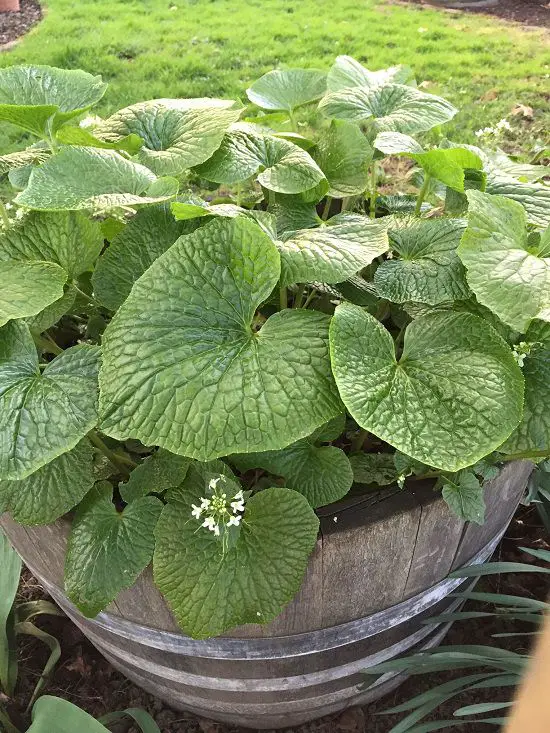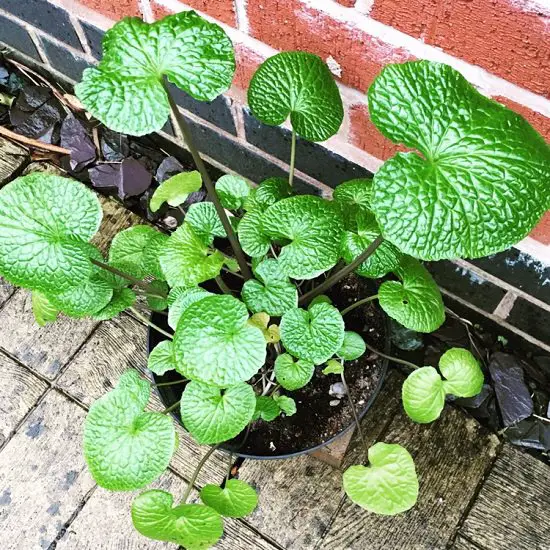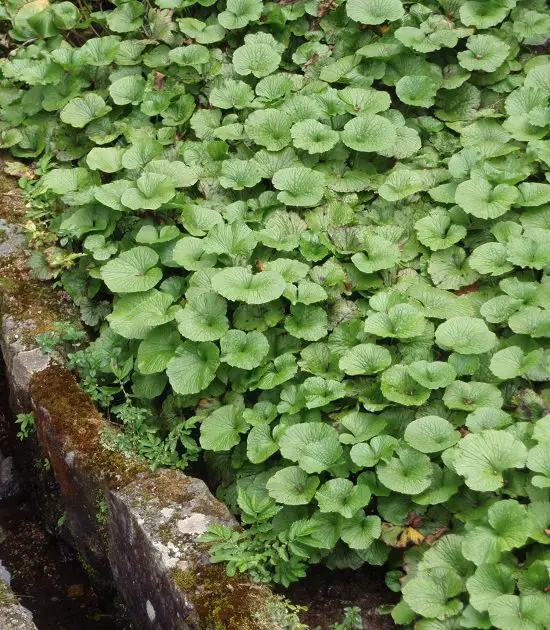Want to know How to Grow Wasabi? It’s not as tough of a task if you follow the instructions right! Learn the method in detail!

Growing wasabi can be tricky, as this Japanese herb is very fussy about its environment, water content, and humidity. It is considered as a tough plant to cultivate and maintain. Learn more about How to Grow Wasabi, its care, and requirements by reading the below article!
Botanical Name: Eutrema japonicum
Other Name: Japanese horseradish
Soil PH: 6-7
Height and Spread: 2 feet tall and wide
Check out our article on growing best Japanese herbs here!
What is Wasabi?
Wasabi (Wasabia japonica) belongs to the Brassicaceae family and is native to the mountain river valley in Japan. This herb is popularly served with sushi in a paste form, which is prepared from ground rhizomes. All parts of wasabi are edible, you can use mature greens to make wasabi flavored ‘Ohitashi,’ young and tender leaves are good for salads and sandwiches.
What Does Wasabi Taste Like?
The taste of wasabi is identical to hot mustard or horseradish. Sometimes, it is also used as a substitute for chili pepper. It tastes close to Western horseradish. Spicy and hot for a moment but a bit sweeter and smooth than horseradish, and taste doesn’t linger.
Where Does Wasabi Grow?
Wasabia japonica grows mainly in the northern parts of Japan. It is also widely cultivated in China, Korea, New Zealand, Taiwan and successfully grows in parts of the Blue Ridge Mountains in North Carolina, rain forests of Oregon Coast, and Tennessee in the United States.
Types of Wasabi

The two main cultivars are Eutrema japonicum ‘Daruma,’ and ‘Mazuma.’ The others are:
- Wasabia japonica
- Cochlearia wasabi
- Wasabi koreana
- Wasabi tetsuigi
- Eutrema japonica
Propagating Wasabi
Getting wasabi plantlets or seeds from nurseries and garden centers might be a tough task, so order them online where they are easily available. If you’ve got the seeds, soak them in distilled water overnight, it will soften the outer covering and expedite the seed germination.
Draw rows in the planting area, around 5-6 inches (13-15 cm) apart. The rows need to be 2 inches (5 cm) deep and 2 inches (5 cm) wide. Sow one seed per hole, water well and cover it with soil. Keep in mind to maintain the moisture around the plants.
If you’re sowing seeds in pots, plant them 1 or 2 inches deep and 2 inches apart. Later transplant them to a bigger container after thinning the weak seedlings. You can also propagate wasabi from plantlets (pups) that grow around the mother plant.
Wasabi Planting Time
According to wasabi growers, the best time for planting is late fall and up to early or mid winters as wasabi seeds need cold winter temperatures to break dormancy, around 2 months before they sprout in February.
If you’re growing it in a hot climate, you can use artificial cold treatment to germinate seeds. It was found that varieties like ‘Daruma’ and ‘Shimane’ started well when exposed to 41 F (5 C) for 2 months. For this, you can keep wasabi seeds in the refrigerator. Plant wasabi outside, when the temperature is around 50-55 F (10-13 C).
Choosing a Container
Start growing wasabi in 8 inches deep container and later transplant it to one or two sizes bigger pot. A standard 10 to 12 inches deep and wide pot should be ideal too, a bigger container like this is going to eliminate the need to replant them after a year.
Requirements for Growing Wasabi Plant

Location
Choose an area with a heavy shade where the plant is protected from direct sunlight. If you are growing it in a garden, plant it under a canopy of a tree or make a shade with a sheet or tarp. An area with 75% is fine for this purpose if you’ve got a North or East facing balcony, wasabi is good to grow there.
Wasabi grows best in a cold, moist and humid spot. A similar environment is preferred by other plants like ferns and wild parsley.
Soil
Wasabi prefers organic-rich, loose and crumbly soil with good drainage and some moist retaining ability, the pH range it prefers is around 6-7. To improve drainage, you can add coarse sand.
Water
Deep and regular watering is required to keep the soil moist and maintain humidity and coolness around the wasabi plant. Overwatering and plant sitting in wet soil must be avoided to prevent root rot, especially if you’re growing wasabi indoors.
Note: Never allow the plant to dry out and wilt.
Temperature
The ideal temperature for growing wasabi is between 54-59 F (12-15 C). Temperature ranges from 46 to 70 F (7.7-21 C) is also considered good. It doesn’t like fluctuating temperature and too much cold or heat. Below 46 F and 82 F (7-27.7 C) is detrimental for the growth of this herb.
Fertilizer
The addition of compost or well-rotted manure is enough, but you can also add a slow-release fertilizer like 12-12-12 at the time of planting. Barely, the dose 1 to 1.5 grams per square foot is enough for 3-4 months. Feeding with balanced liquid fertilizer rich in sulfur is also an option.
Pro Tip: Commercial growers feed wasabi plant with a sulfur foliar spray 1-3 months before the harvest to enhance the spiciness and flavor. Since Epsom salt has sulfur (Magnesium sulfate), you can apply it too.
Pruning
Prune away wilted, dead, damaged and diseased leaves from the plant, as they can attract pests and diseases.
Pests and Diseases
You have to be careful about aphids, alfalfa looper larva, cranefly larva, and slugs. Keep the plant at a cool location. If you’re growing just a couple of plants, handpick the pests and squeeze them one by one.
However, if you don’t like this idea and don’t want to use chemical pesticides, try drenching the affected foliage with insecticidal soap or neem oil spray on the plants for prevention. If a plant is severely affected, remove it.
Leaf spot, root rot, and rhizome rot are some of the diseases that affect it. Precautions with watering, especially when growing wasabi indoors can save your plant.
Here’re some best natural ways to get rid of aphids!
Growing Wasabi Indoors
If you live in a region, where the temperature fluctuates a lot and it’s cold or hot, the place to grow wasabi is indoors. A basement, or near a North or East facing window is the best place. Somewhere where you can maintain its temperature requirement listed above. All the growing instructions are similar.
Harvesting and Storage

The best thing about wasabi is all parts of the plant are edible! You can start harvesting the leaf stems, leaves and flowers when the plant reaches 4-6 inches in height. You can harvest the rhizomes by pulling the entire plant up. Even the roots of the plant are edible!
The rhizomes can be put in in the refrigerator for a month or so but the best flavor you get fresh, clean and grate the roots and use within 30 minutes. You can also dry and grind it for longer shelf life.
Wasabi Uses
- You can eat it in both cooked and raw forms, including sautéing and stir-frying.
- Add it in salads, garnishing sushi rolls, topping for miso soup, udon, or soba.
- It is also popular for making a pickle dish called the wasabi-zuke.
- The paste of the rhizomes enhances the taste of poultry and sausage recipes. You can also have it with steamed rice or on toast.
Not only it’s a delicious addition to meals, but it also has several health benefits on offer. Its roots have anti-inflammatory properties that aid in better circulation. It also has anti-microbial properties that can help in combating an upset stomach.



